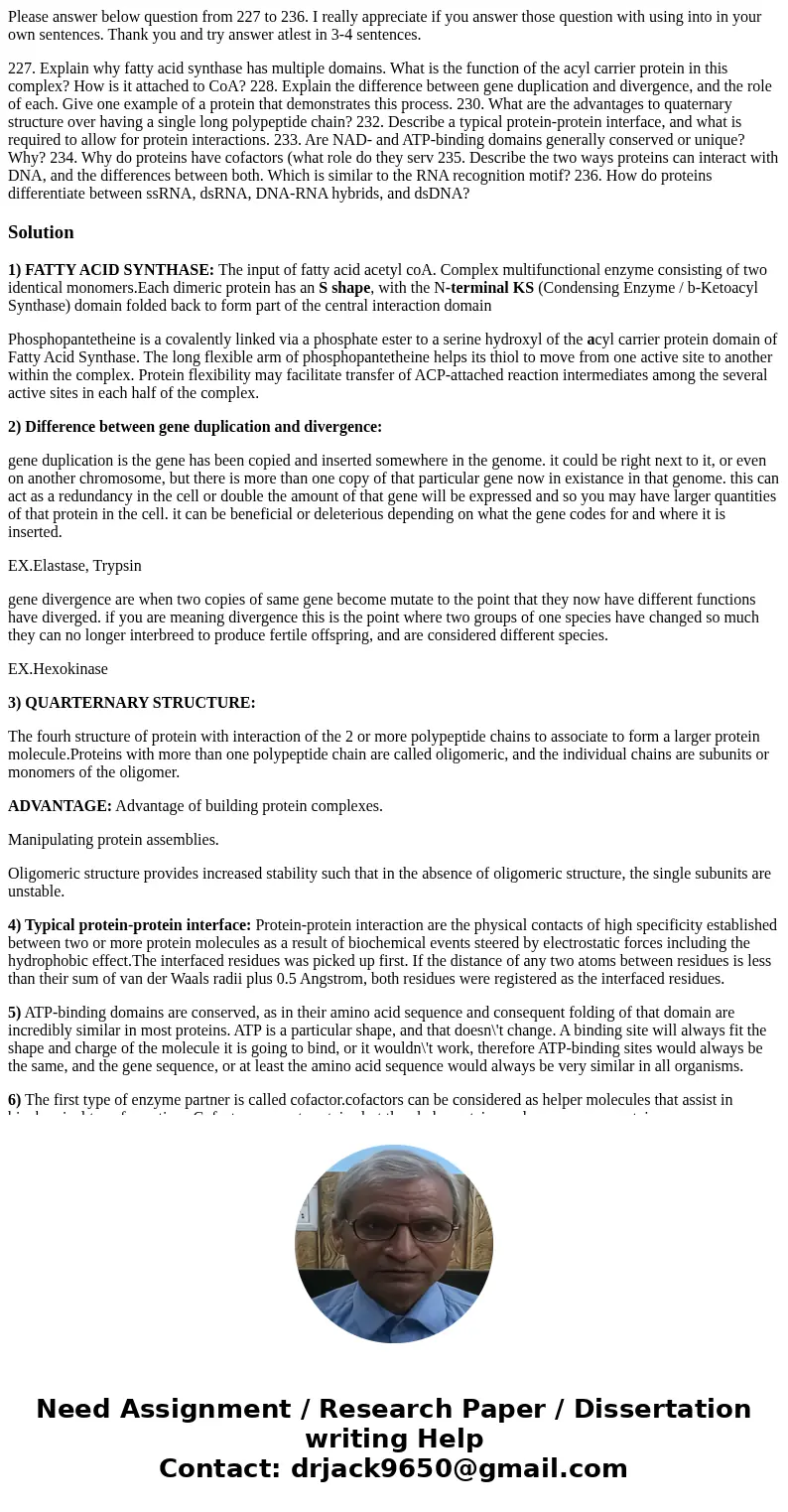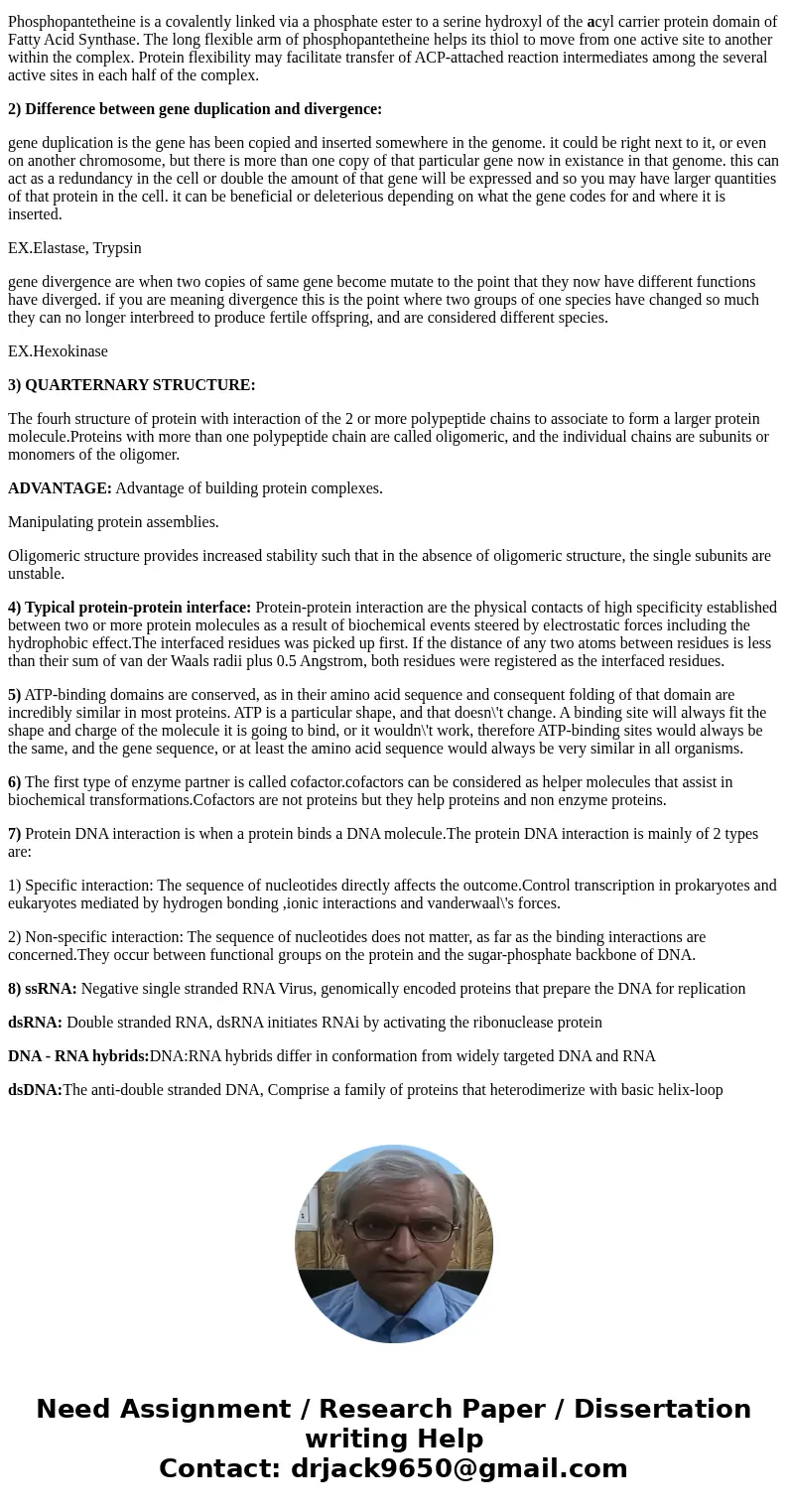Please answer below question from 227 to 236 I really apprec
Please answer below question from 227 to 236. I really appreciate if you answer those question with using into in your own sentences. Thank you and try answer atlest in 3-4 sentences.
227. Explain why fatty acid synthase has multiple domains. What is the function of the acyl carrier protein in this complex? How is it attached to CoA? 228. Explain the difference between gene duplication and divergence, and the role of each. Give one example of a protein that demonstrates this process. 230. What are the advantages to quaternary structure over having a single long polypeptide chain? 232. Describe a typical protein-protein interface, and what is required to allow for protein interactions. 233. Are NAD- and ATP-binding domains generally conserved or unique? Why? 234. Why do proteins have cofactors (what role do they serv 235. Describe the two ways proteins can interact with DNA, and the differences between both. Which is similar to the RNA recognition motif? 236. How do proteins differentiate between ssRNA, dsRNA, DNA-RNA hybrids, and dsDNA?Solution
1) FATTY ACID SYNTHASE: The input of fatty acid acetyl coA. Complex multifunctional enzyme consisting of two identical monomers.Each dimeric protein has an S shape, with the N-terminal KS (Condensing Enzyme / b-Ketoacyl Synthase) domain folded back to form part of the central interaction domain
Phosphopantetheine is a covalently linked via a phosphate ester to a serine hydroxyl of the acyl carrier protein domain of Fatty Acid Synthase. The long flexible arm of phosphopantetheine helps its thiol to move from one active site to another within the complex. Protein flexibility may facilitate transfer of ACP-attached reaction intermediates among the several active sites in each half of the complex.
2) Difference between gene duplication and divergence:
gene duplication is the gene has been copied and inserted somewhere in the genome. it could be right next to it, or even on another chromosome, but there is more than one copy of that particular gene now in existance in that genome. this can act as a redundancy in the cell or double the amount of that gene will be expressed and so you may have larger quantities of that protein in the cell. it can be beneficial or deleterious depending on what the gene codes for and where it is inserted.
EX.Elastase, Trypsin
gene divergence are when two copies of same gene become mutate to the point that they now have different functions have diverged. if you are meaning divergence this is the point where two groups of one species have changed so much they can no longer interbreed to produce fertile offspring, and are considered different species.
EX.Hexokinase
3) QUARTERNARY STRUCTURE:
The fourh structure of protein with interaction of the 2 or more polypeptide chains to associate to form a larger protein molecule.Proteins with more than one polypeptide chain are called oligomeric, and the individual chains are subunits or monomers of the oligomer.
ADVANTAGE: Advantage of building protein complexes.
Manipulating protein assemblies.
Oligomeric structure provides increased stability such that in the absence of oligomeric structure, the single subunits are unstable.
4) Typical protein-protein interface: Protein-protein interaction are the physical contacts of high specificity established between two or more protein molecules as a result of biochemical events steered by electrostatic forces including the hydrophobic effect.The interfaced residues was picked up first. If the distance of any two atoms between residues is less than their sum of van der Waals radii plus 0.5 Angstrom, both residues were registered as the interfaced residues.
5) ATP-binding domains are conserved, as in their amino acid sequence and consequent folding of that domain are incredibly similar in most proteins. ATP is a particular shape, and that doesn\'t change. A binding site will always fit the shape and charge of the molecule it is going to bind, or it wouldn\'t work, therefore ATP-binding sites would always be the same, and the gene sequence, or at least the amino acid sequence would always be very similar in all organisms.
6) The first type of enzyme partner is called cofactor.cofactors can be considered as helper molecules that assist in biochemical transformations.Cofactors are not proteins but they help proteins and non enzyme proteins.
7) Protein DNA interaction is when a protein binds a DNA molecule.The protein DNA interaction is mainly of 2 types are:
1) Specific interaction: The sequence of nucleotides directly affects the outcome.Control transcription in prokaryotes and eukaryotes mediated by hydrogen bonding ,ionic interactions and vanderwaal\'s forces.
2) Non-specific interaction: The sequence of nucleotides does not matter, as far as the binding interactions are concerned.They occur between functional groups on the protein and the sugar-phosphate backbone of DNA.
8) ssRNA: Negative single stranded RNA Virus, genomically encoded proteins that prepare the DNA for replication
dsRNA: Double stranded RNA, dsRNA initiates RNAi by activating the ribonuclease protein
DNA - RNA hybrids:DNA:RNA hybrids differ in conformation from widely targeted DNA and RNA
dsDNA:The anti-double stranded DNA, Comprise a family of proteins that heterodimerize with basic helix-loop


 Homework Sourse
Homework Sourse